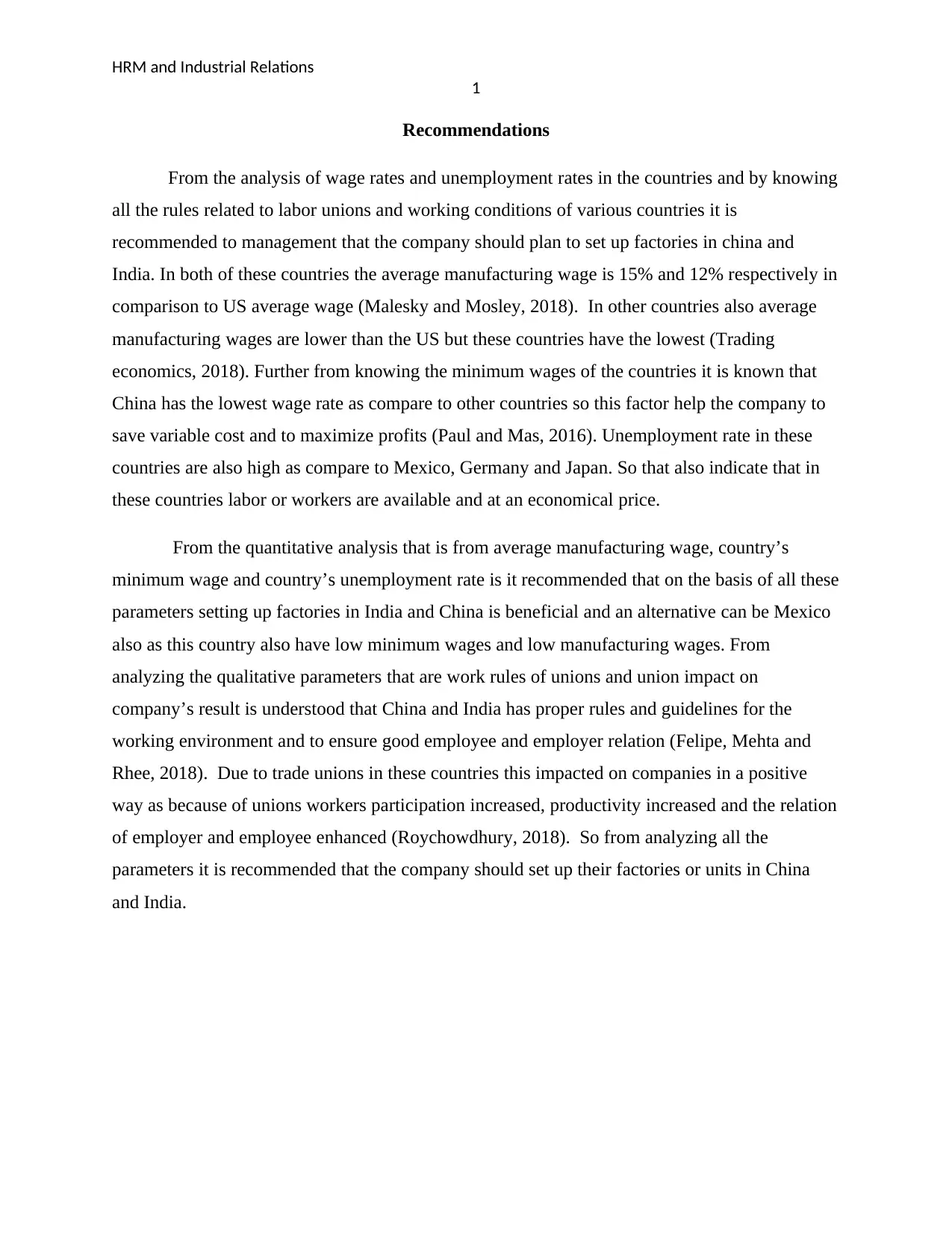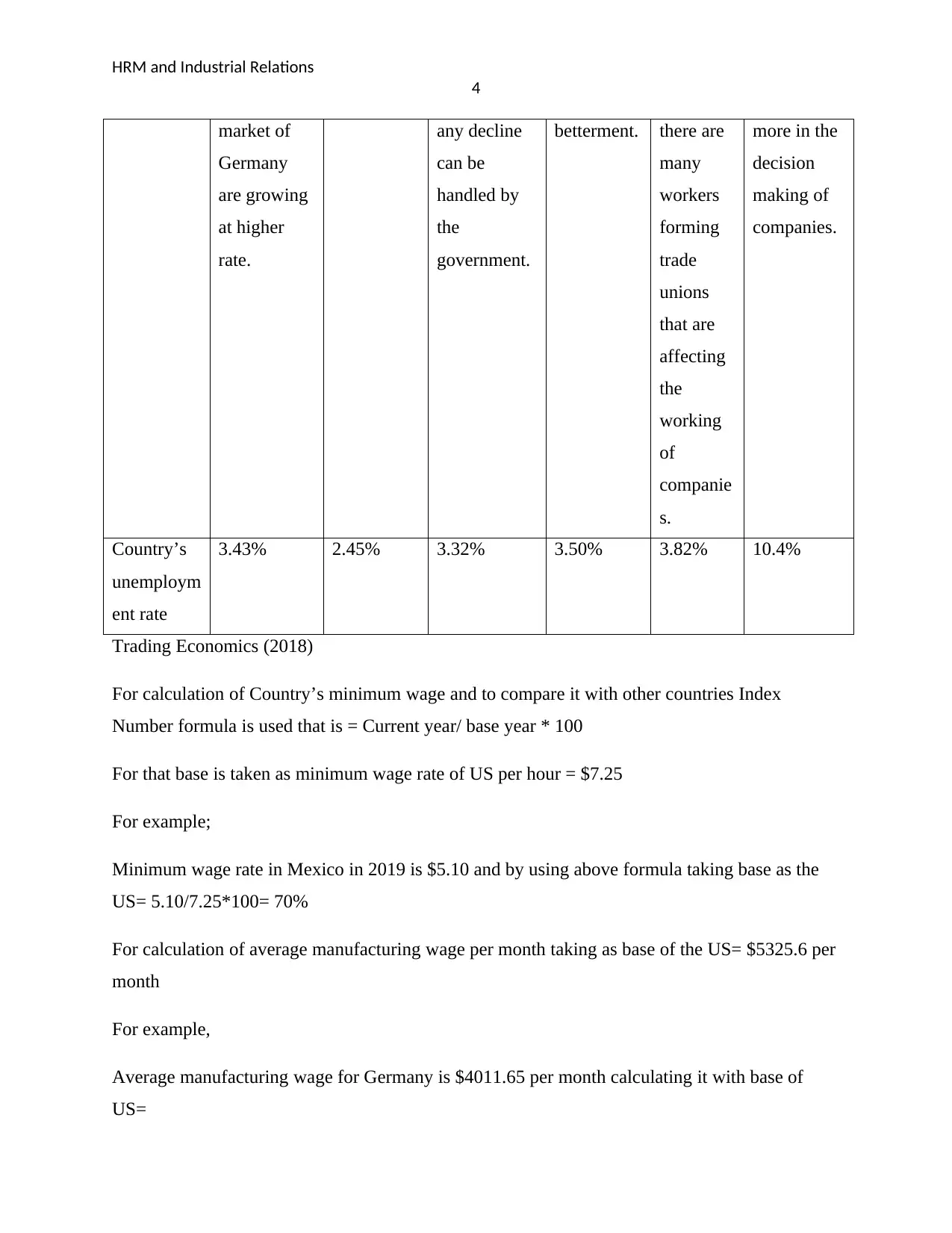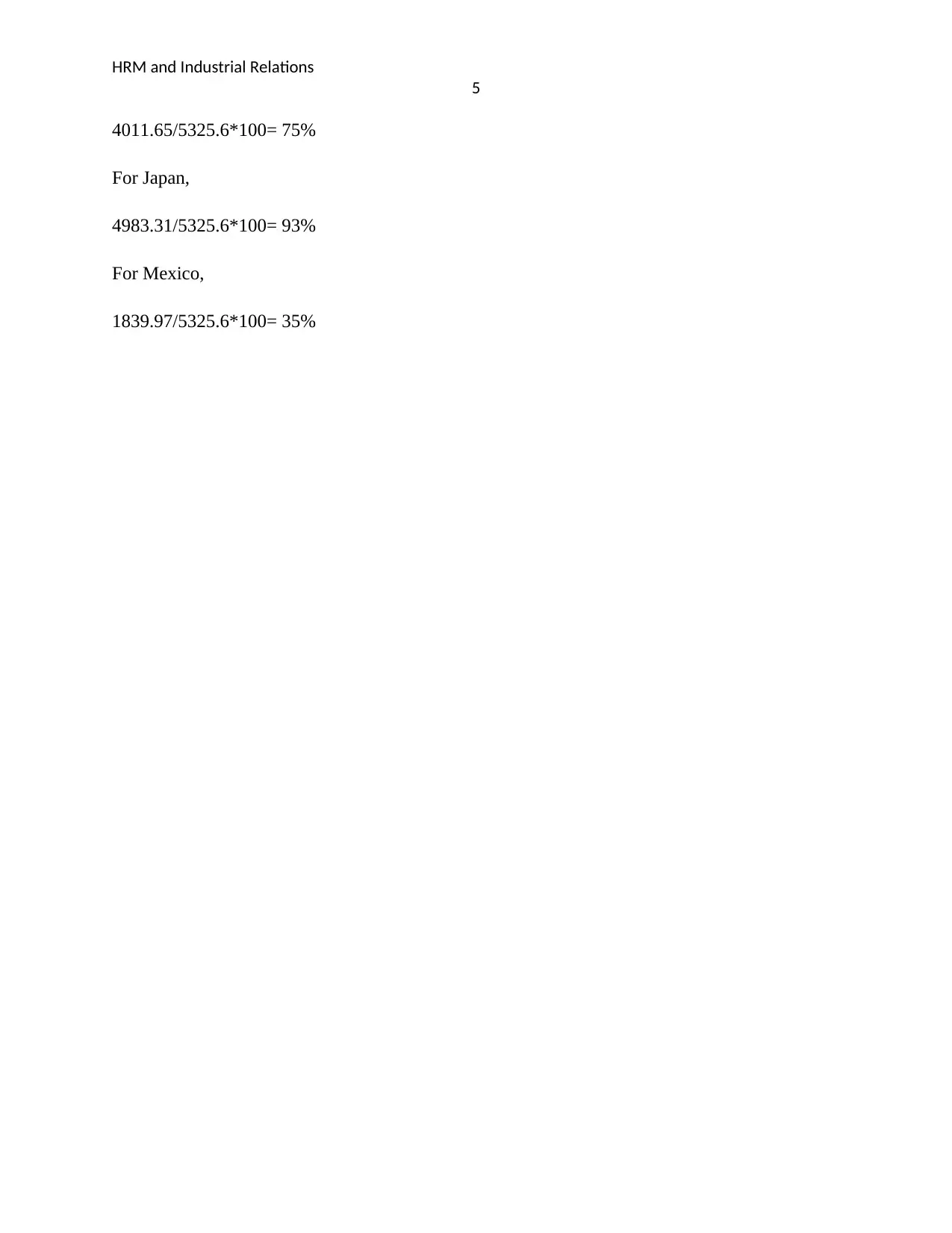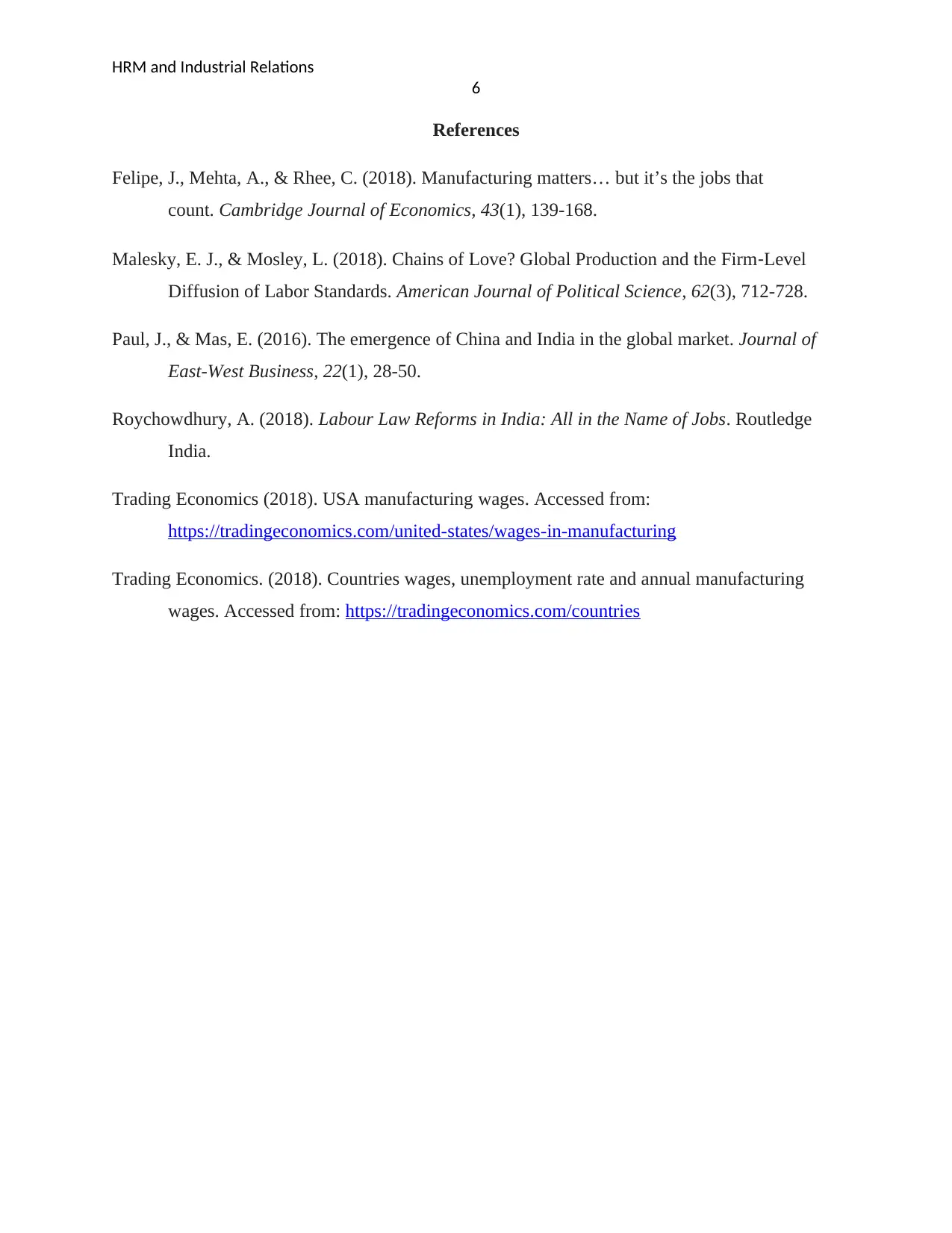HRM and Industrial Relations Assignment 2022
VerifiedAdded on 2022/10/17
|7
|1275
|10
Assignment
AI Summary
Contribute Materials
Your contribution can guide someone’s learning journey. Share your
documents today.

RUNNING HEAD: HRM AND INDUSTRIAL RELATIONS
0
HRM and Industrial Relation
System 0032
[Pick the date]
0
HRM and Industrial Relation
System 0032
[Pick the date]
Secure Best Marks with AI Grader
Need help grading? Try our AI Grader for instant feedback on your assignments.

HRM and Industrial Relations
1
Recommendations
From the analysis of wage rates and unemployment rates in the countries and by knowing
all the rules related to labor unions and working conditions of various countries it is
recommended to management that the company should plan to set up factories in china and
India. In both of these countries the average manufacturing wage is 15% and 12% respectively in
comparison to US average wage (Malesky and Mosley, 2018). In other countries also average
manufacturing wages are lower than the US but these countries have the lowest (Trading
economics, 2018). Further from knowing the minimum wages of the countries it is known that
China has the lowest wage rate as compare to other countries so this factor help the company to
save variable cost and to maximize profits (Paul and Mas, 2016). Unemployment rate in these
countries are also high as compare to Mexico, Germany and Japan. So that also indicate that in
these countries labor or workers are available and at an economical price.
From the quantitative analysis that is from average manufacturing wage, country’s
minimum wage and country’s unemployment rate is it recommended that on the basis of all these
parameters setting up factories in India and China is beneficial and an alternative can be Mexico
also as this country also have low minimum wages and low manufacturing wages. From
analyzing the qualitative parameters that are work rules of unions and union impact on
company’s result is understood that China and India has proper rules and guidelines for the
working environment and to ensure good employee and employer relation (Felipe, Mehta and
Rhee, 2018). Due to trade unions in these countries this impacted on companies in a positive
way as because of unions workers participation increased, productivity increased and the relation
of employer and employee enhanced (Roychowdhury, 2018). So from analyzing all the
parameters it is recommended that the company should set up their factories or units in China
and India.
1
Recommendations
From the analysis of wage rates and unemployment rates in the countries and by knowing
all the rules related to labor unions and working conditions of various countries it is
recommended to management that the company should plan to set up factories in china and
India. In both of these countries the average manufacturing wage is 15% and 12% respectively in
comparison to US average wage (Malesky and Mosley, 2018). In other countries also average
manufacturing wages are lower than the US but these countries have the lowest (Trading
economics, 2018). Further from knowing the minimum wages of the countries it is known that
China has the lowest wage rate as compare to other countries so this factor help the company to
save variable cost and to maximize profits (Paul and Mas, 2016). Unemployment rate in these
countries are also high as compare to Mexico, Germany and Japan. So that also indicate that in
these countries labor or workers are available and at an economical price.
From the quantitative analysis that is from average manufacturing wage, country’s
minimum wage and country’s unemployment rate is it recommended that on the basis of all these
parameters setting up factories in India and China is beneficial and an alternative can be Mexico
also as this country also have low minimum wages and low manufacturing wages. From
analyzing the qualitative parameters that are work rules of unions and union impact on
company’s result is understood that China and India has proper rules and guidelines for the
working environment and to ensure good employee and employer relation (Felipe, Mehta and
Rhee, 2018). Due to trade unions in these countries this impacted on companies in a positive
way as because of unions workers participation increased, productivity increased and the relation
of employer and employee enhanced (Roychowdhury, 2018). So from analyzing all the
parameters it is recommended that the company should set up their factories or units in China
and India.

HRM and Industrial Relations
2
Germany Japan Mexico India China Italy
Average
manufactur
ing wage
75% 93% 35% 12% 15% 62%
Country’s
minimum
wage
140% 113% 70% 100% 45% 106%
Rules of
union
There are
various acts
for
protection of
employers
and
employees
in German
such as Civil
code,
minimum
wage, part
time act and
vacation
entitlement
act. 8 to 10
hours of
working in a
day with 45
minutes
break.
Further, 20
days of
minimum
In Japan,
according
to labor
laws the
workers
working
hours
should not
exceed 40
hours in a
week and
overtime
for not
more than
45 hours in
a month.
For
overtime,
wages
should be
paid to
125% of
the normal
wages.
In Mexico
unions have
right to
intervene in
the decision
of
management
and for
collective
bargaining
unions can
do strikes.
Further
unions have
right to make
their
regulations.
There is no
notice period
for the
employees
they can
level when
they
According
to factories
act in India
workers
can work
only for 8
hours a day
and 48
hours in a
week.
Overtime
wages will
be doubled
the basic
wage and
age should
be more
than 18
years.
Trade
union act
formulated
to protect
the rights
The
independe
nt union is
illegal in
China. As
to
safeguard
the
interest of
workers
governme
nt
formulate
d one
union for
all named
as “All-
China
Federation
of Trade
Union”.
So there is
no such
role of
The trade
unions in
Italy have
rights to
participate,
right to do
strike and
right to get
informed
about
manageme
nt decision.
Trade
unions
follow
Italian law
and have
limited
right as per
the act
formulated
by the
governmen
t. The
2
Germany Japan Mexico India China Italy
Average
manufactur
ing wage
75% 93% 35% 12% 15% 62%
Country’s
minimum
wage
140% 113% 70% 100% 45% 106%
Rules of
union
There are
various acts
for
protection of
employers
and
employees
in German
such as Civil
code,
minimum
wage, part
time act and
vacation
entitlement
act. 8 to 10
hours of
working in a
day with 45
minutes
break.
Further, 20
days of
minimum
In Japan,
according
to labor
laws the
workers
working
hours
should not
exceed 40
hours in a
week and
overtime
for not
more than
45 hours in
a month.
For
overtime,
wages
should be
paid to
125% of
the normal
wages.
In Mexico
unions have
right to
intervene in
the decision
of
management
and for
collective
bargaining
unions can
do strikes.
Further
unions have
right to make
their
regulations.
There is no
notice period
for the
employees
they can
level when
they
According
to factories
act in India
workers
can work
only for 8
hours a day
and 48
hours in a
week.
Overtime
wages will
be doubled
the basic
wage and
age should
be more
than 18
years.
Trade
union act
formulated
to protect
the rights
The
independe
nt union is
illegal in
China. As
to
safeguard
the
interest of
workers
governme
nt
formulate
d one
union for
all named
as “All-
China
Federation
of Trade
Union”.
So there is
no such
role of
The trade
unions in
Italy have
rights to
participate,
right to do
strike and
right to get
informed
about
manageme
nt decision.
Trade
unions
follow
Italian law
and have
limited
right as per
the act
formulated
by the
governmen
t. The

HRM and Industrial Relations
3
vacation to
each
employee in
a year.
Trade
unions
have
limited
right in
japan and
work
councils
are not
allowed.
informed to
the
management.
of
employers
and
employees.
Labor
union
intervenes
in workers
misconduct
,
retrenchme
nt and
layoff to
protect
them from
uncertain
events.
union in
China.
working
hours and
overtime
wages is
given to
workers as
per the law.
Impact of
unions on
company
results
Trade
unions in
Germany
coordinate
with their
employers
and bring
positive
change in
the company
productivity
and growth
and due to
that labor
18 percent
of workers
in Japan
work under
labor union
and the
effect of
union in
companies
is less as
most of the
workers are
independen
t.
The control
of
government
in union is
more in
Mexico as
this resultant
in less power
in hand of
union to
affect the
companies
result or
working as
In India,
unionism
proves to
be
beneficial
for the
companies
as the
unions
brought
social,
political
and
economic
Mainly in
China
earlier
there was
no role of
unions
but
because
of
increasin
g
exploitati
on of
workers
The labor
unions in
Italy are
powerful
that
impacted on
the
company
performanc
e in
negative
way. As
interference
of union is
3
vacation to
each
employee in
a year.
Trade
unions
have
limited
right in
japan and
work
councils
are not
allowed.
informed to
the
management.
of
employers
and
employees.
Labor
union
intervenes
in workers
misconduct
,
retrenchme
nt and
layoff to
protect
them from
uncertain
events.
union in
China.
working
hours and
overtime
wages is
given to
workers as
per the law.
Impact of
unions on
company
results
Trade
unions in
Germany
coordinate
with their
employers
and bring
positive
change in
the company
productivity
and growth
and due to
that labor
18 percent
of workers
in Japan
work under
labor union
and the
effect of
union in
companies
is less as
most of the
workers are
independen
t.
The control
of
government
in union is
more in
Mexico as
this resultant
in less power
in hand of
union to
affect the
companies
result or
working as
In India,
unionism
proves to
be
beneficial
for the
companies
as the
unions
brought
social,
political
and
economic
Mainly in
China
earlier
there was
no role of
unions
but
because
of
increasin
g
exploitati
on of
workers
The labor
unions in
Italy are
powerful
that
impacted on
the
company
performanc
e in
negative
way. As
interference
of union is
Secure Best Marks with AI Grader
Need help grading? Try our AI Grader for instant feedback on your assignments.

HRM and Industrial Relations
4
market of
Germany
are growing
at higher
rate.
any decline
can be
handled by
the
government.
betterment. there are
many
workers
forming
trade
unions
that are
affecting
the
working
of
companie
s.
more in the
decision
making of
companies.
Country’s
unemploym
ent rate
3.43% 2.45% 3.32% 3.50% 3.82% 10.4%
Trading Economics (2018)
For calculation of Country’s minimum wage and to compare it with other countries Index
Number formula is used that is = Current year/ base year * 100
For that base is taken as minimum wage rate of US per hour = $7.25
For example;
Minimum wage rate in Mexico in 2019 is $5.10 and by using above formula taking base as the
US= 5.10/7.25*100= 70%
For calculation of average manufacturing wage per month taking as base of the US= $5325.6 per
month
For example,
Average manufacturing wage for Germany is $4011.65 per month calculating it with base of
US=
4
market of
Germany
are growing
at higher
rate.
any decline
can be
handled by
the
government.
betterment. there are
many
workers
forming
trade
unions
that are
affecting
the
working
of
companie
s.
more in the
decision
making of
companies.
Country’s
unemploym
ent rate
3.43% 2.45% 3.32% 3.50% 3.82% 10.4%
Trading Economics (2018)
For calculation of Country’s minimum wage and to compare it with other countries Index
Number formula is used that is = Current year/ base year * 100
For that base is taken as minimum wage rate of US per hour = $7.25
For example;
Minimum wage rate in Mexico in 2019 is $5.10 and by using above formula taking base as the
US= 5.10/7.25*100= 70%
For calculation of average manufacturing wage per month taking as base of the US= $5325.6 per
month
For example,
Average manufacturing wage for Germany is $4011.65 per month calculating it with base of
US=

HRM and Industrial Relations
5
4011.65/5325.6*100= 75%
For Japan,
4983.31/5325.6*100= 93%
For Mexico,
1839.97/5325.6*100= 35%
5
4011.65/5325.6*100= 75%
For Japan,
4983.31/5325.6*100= 93%
For Mexico,
1839.97/5325.6*100= 35%

HRM and Industrial Relations
6
References
Felipe, J., Mehta, A., & Rhee, C. (2018). Manufacturing matters… but it’s the jobs that
count. Cambridge Journal of Economics, 43(1), 139-168.
Malesky, E. J., & Mosley, L. (2018). Chains of Love? Global Production and the Firm‐Level
Diffusion of Labor Standards. American Journal of Political Science, 62(3), 712-728.
Paul, J., & Mas, E. (2016). The emergence of China and India in the global market. Journal of
East-West Business, 22(1), 28-50.
Roychowdhury, A. (2018). Labour Law Reforms in India: All in the Name of Jobs. Routledge
India.
Trading Economics (2018). USA manufacturing wages. Accessed from:
https://tradingeconomics.com/united-states/wages-in-manufacturing
Trading Economics. (2018). Countries wages, unemployment rate and annual manufacturing
wages. Accessed from: https://tradingeconomics.com/countries
6
References
Felipe, J., Mehta, A., & Rhee, C. (2018). Manufacturing matters… but it’s the jobs that
count. Cambridge Journal of Economics, 43(1), 139-168.
Malesky, E. J., & Mosley, L. (2018). Chains of Love? Global Production and the Firm‐Level
Diffusion of Labor Standards. American Journal of Political Science, 62(3), 712-728.
Paul, J., & Mas, E. (2016). The emergence of China and India in the global market. Journal of
East-West Business, 22(1), 28-50.
Roychowdhury, A. (2018). Labour Law Reforms in India: All in the Name of Jobs. Routledge
India.
Trading Economics (2018). USA manufacturing wages. Accessed from:
https://tradingeconomics.com/united-states/wages-in-manufacturing
Trading Economics. (2018). Countries wages, unemployment rate and annual manufacturing
wages. Accessed from: https://tradingeconomics.com/countries
1 out of 7
Your All-in-One AI-Powered Toolkit for Academic Success.
+13062052269
info@desklib.com
Available 24*7 on WhatsApp / Email
![[object Object]](/_next/static/media/star-bottom.7253800d.svg)
Unlock your academic potential
© 2024 | Zucol Services PVT LTD | All rights reserved.

